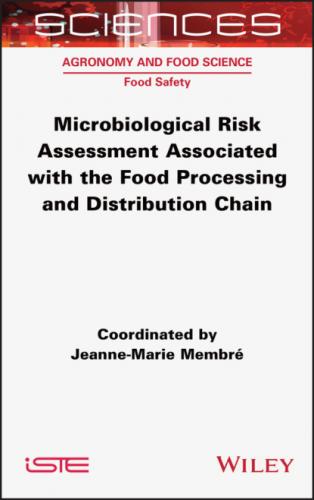The purpose of microbiological risk assessment is to characterize the nature and probability of harm resulting from human exposure to the biological agents present in foodstuffs. Ever since 1999, the WHO and the FAO, through the Codex Alimentarius Commission (CAC), have set out principles and guidelines for conducting microbiological risk assessment of food (Codex Alimentarius Commission 1999). Since then, they have regularly augmented their work; for example, in 2020 they produced a very comprehensive methodological document (FAO and WHO 2020).
Microbiological risk assessment of food is a scientific process comprising four elements (Figure I.3): hazard identification, hazard characterization, exposure assessment and finally risk characterization. In the context of production, distribution and consumption of food products, the risks must take into account all stages of the chain: from the production of raw materials (“farm”) to consumption (“fork”), and even through to ingestion (“human”). Microbiological risk assessment thus covers the “farm-to-fork-to-human” continuum. Of course, depending on the food product, its composition, its manufacture and its packaging, the key steps to be taken into account in the risk assessment can be mostly upstream or mostly downstream of this continuum.
In 2000, the WHO and the FAO assembled a group of experts on the subject of microbiological risk assessment: JEMRA. JEMRA aims to develop and optimize the utility of microbiological risk assessment as a tool informing actions and decisions in order to improve food safety and make it available to developed and developing countries (FAO 2020). We strongly recommend the reader follow the work carried out by JEMRA and also consult on a regular basis the WHO and FAO websites dedicated to food safety and microbiological risk assessment.
Figure I.3. Microbiological risk assessment. Adapted from the FAO and WHO (2020)
The first chapter of this book deals with the first stage of microbiological risk assessment, namely hazard identification. It remains fairly general since the first book in this series is dedicated to hazard analysis (Haddad 2022). The other three stages of microbiological risk assessment, namely hazard characterization, exposure assessment and finally risk characterization, are, however, developed in the various chapters of this book. More specifically, in order to address the biological and mathematical aspects of these steps, hazard characterization and exposure assessment have each been divided into two parts: hazard characterization is subdivided into a pathogenicity mechanism and quantification of the dose–response; exposure assessment is subdivided into methods of detection and enumeration of pathogens and quantification of the level of exposure.
References
ANSES (2018). Avis et rapport de l’Anses relatif à l’attribution des sources des maladies infectieuses d’origine alimentaire. Partie 2 : Analyse des données épidémiologiques. Report [Online]. Available at: https://www.anses.fr/fr/system/files/BIORISK2015SA0162Ra-2.pdf.
Camel, V., Rivière, G., Le Bizec, B. (2018). Risques chimiques liés aux aliments : principes et applications. Lavoisier, Paris.
Codex Alimentarius Commission (1999). Principles and guidelines for the conduct of microbiological risk assessment. CAC/GL 30-1999.
FAO (2020). Microbiological risks and JEMRA [Online]. Available at: http://www.fao.org/food/food-safety-quality/scientific-advice/jemra/en/ [Accessed 10 February 2020].
FAO and WHO (2006). Food safety risk analysis: A guide for national food safety authorities [Online]. Available at: http://www.fao.org/3/a-a0822e.pdf. [Accessed November 2021].
FAO and WHO (2020). Public consultation for draft guidance of microbiological risk assessment for food [Online]. Available at: https://www.who.int/news-room/articles-detail/public-consultation-for-draft-guidance-of-microbiological-risk-assessment-for-food [Accessed 15 June 2020].
Haddad, N. (2022). Hazards in the Food Processing and Distribution Chain. ISTE Ltd, London and Wiley, New York.
WHO (2015). WHO estimates of the global burden of foodborne diseases. Foodborne Diseases Burden Epidemiology Reference Group [Online]. Available at: https://www.who.int/foodsafety/publications/foodbome_disease/fergreport/en/ [Accessed January 2021].
WHO (2017). The burden of foodborne diseases in the WHO European Region [Online]. Available at: https://www.euro.who.int/__data/assets/pdf_file/0005/402989/50607-WHO-Food-Safety-publicationV4_Web.pdf.
1
Biological Hazard Identification
Jeanne-Marie MEMBRÉ and Nabila HADDAD
SECALIM, INRAE, Oniris, Nantes, France
1.1. Introduction
Contamination of food with microbial agents is a global public health problem. Microbial hazards in food include bacteria such as Salmonella, viruses such as norovirus, parasites such as trematodes and also prions. Diarrheal diseases are the most common diseases resulting from the consumption of contaminated food and are the cause of 550 million illnesses and 230,000 deaths each year (WHO 2020). Hazard identification serves to establish whether the hazard is probable or actual in the food product and to document important known information about the relationships and interactions between the hazard, the food and the host, and also their relationship to human disease. Given that a wide range of microbiological hazards can cause foodborne illness, hazard identification should determine whether a potential hazard is realistic for the food product concerned (FAO and WHO 2020).
Epidemiological data from disease surveillance programs or investigations of food-borne outbreaks are often the first clearly documented indications of a food safety issue associated with a pathogen causing adverse effects. Food contamination surveillance data, along with product and process assessments, can help identify combinations of hazards and foods. Evidence from these sources is usually quantitative (i.e. it includes information on the concentration or number of units of the hazard in the food) and may also provide information that feeds into other stages of microbiological risk assessment, such as exposure assessment and/or establishment of a dose–response relationship. Whole genome sequencing (WGS) is increasingly used for the surveillance of foodborne pathogens, the investigation of epidemics and the search for the sources of contamination throughout the food supply chain (Rantsiou et al. 2018).
That being said, the epidemiological data must be cross-referenced with product knowledge, in other words its formulation, its process, its distribution channel and the way it is used by the consumer, before conclusions can be drawn on the relevant
